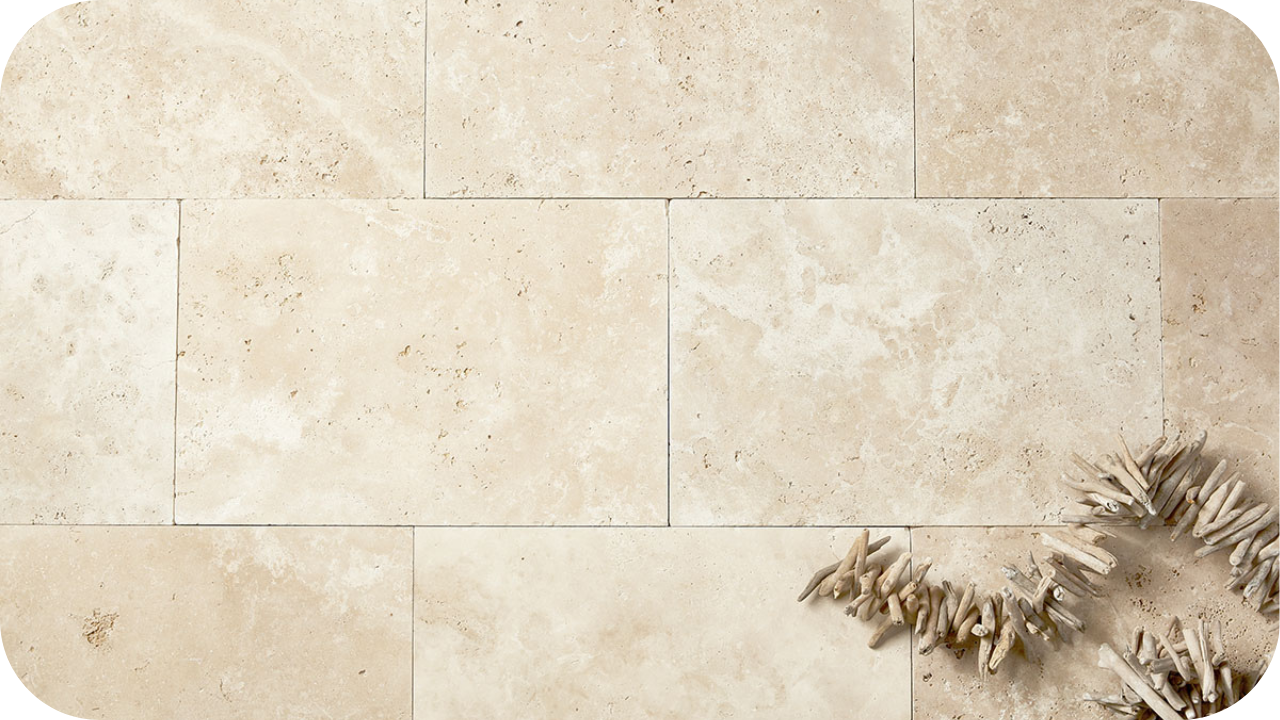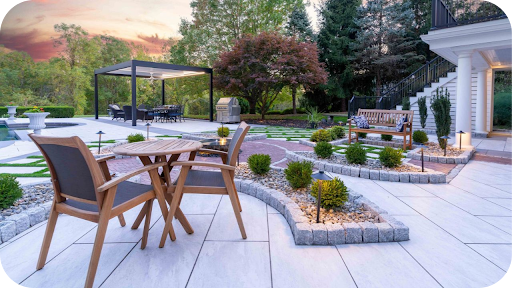
Travertine is a form of natural limestone created by mineral-rich water, often from hot springs or cave systems.
Travertine forms through the slow accumulation of calcium carbonate, leaving behind a stone with unique pits, subtle veining, and organic variation. It has been prized for centuries for its timeless appearance and natural elegance.
In Australia, it is widely used in both paving and walling applications. Its warm, textured look is equally sophisticated for courtyards, pool surrounds, feature facades, and indoor flooring.
What Is Travertine?
Travertine is a natural limestone formed by mineral deposits from hot springs and caves. It features a porous texture and earthy tones such as ivory, beige, and silver. Used for both paving and walling, travertine offers timeless appeal, cool underfoot comfort, and subtle veining that enhances architectural and landscape designs in both indoor and outdoor settings.
Key Characteristics of Travertine
Travertine is known for its natural warmth, subtle textures, and unique surface qualities. Here’s what makes this stone stand out in both walling and paving applications.
1. Naturally Formed Voids and Pits
Travertine is characterised by small surface holes and voids formed during mineral deposition. These irregularities give the stone its signature raw, organic appearance whether filled or left natural.
2. Soft, Earth-Toned Colour Palette
Travertine typically appears in neutral shades such as ivory, beige, tan, walnut, and silver. These soft, natural tones result from mineral content and layering during formation in geothermal areas.
3. Layered and Banded Appearance
Travertine often displays subtle layers or bands, a result of accumulated sediment over time. This gives the stone visual depth and variation, enhancing its natural appeal without the need for dramatic veining.
4. Mid-Level Hardness
Travertine is softer than granite but harder than many limestones. This balanced composition allows it to be both workable and structurally stable, ideal for shaping into tiles, panels, and other formats.
5. Porous Structure
Formed by rapid precipitation of calcium carbonate, travertine has a naturally porous matrix. This texture varies slightly between blocks, contributing to its tactile, weathered character across different finishes.
Travertine Varieties and Surface Finishes
Travertine’s versatility is reflected in its rich selection of varieties that suit both walling and paving. Each option offers distinct colours and textures, making it ideal for timeless and cohesive designs.
1. Silver Travertine
Silver travertine showcases a blend of grey, silver, and beige tones with soft veining. Available in tumbled, honed, or brushed finishes, it suits both paving and walling, offering a modern yet organic appearance.
2. Classic Travertine
Classic travertine is warm and timeless, with cream and beige tones. Commonly available in honed, tumbled, and filled finishes, it’s ideal for walling and paving, bringing soft texture and elegance to any space.
3. Ivory Travertine
Ivory travertine offers soft, pale tones with occasional warmth. Favoured in honed and tumbled finishes, it brightens both paving and vertical surfaces, lending a sense of understated luxury and clean architectural flow.
4. Walnut Travertine
Walnut travertine features rich, earthy brown hues and subtle movement. Available in brushed, honed, and tumbled finishes, it adds depth to both walls and paving, especially when paired with timber or garden elements.
5. Noce Travertine
Noce travertine is known for its dark, coffee-coloured base and uniform appearance. Supplied in honed and filled, or tumbled finishes, it suits both vertical and horizontal applications, offering contrast and warmth.
Common Applications of Travertine
Travertine suits a wide range of indoor and outdoor spaces thanks to its versatility in form and finish. Here’s how this natural stone enhances various areas of the home and garden:
1. Courtyards and Patios
Travertine brings warmth and elegance to courtyards and patios. Its natural tones and textured finishes make it perfect for relaxed outdoor settings that blend beautifully with landscaping.
2. Pool Coping and Surrounds
Thanks to its cool-to-touch surface and natural grip in brushed or tumbled finishes, travertine is a favourite for pool coping and paving, offering comfort and visual appeal in sunny areas.
3. Wall Cladding and Facades
Travertine adds texture and depth to vertical spaces. Used in both interior and exterior cladding, it enhances feature walls and facades with a refined, timeless finish.
4. Indoor Flooring
Travertine tiles in honed or filled finishes are ideal for kitchens, hallways, and bathrooms. They provide a high-end look while maintaining a soft, natural underfoot feel.
5. Garden Paths and Steppers
Tumbled travertine makes for inviting garden paths and stepping stones. The soft edges and organic colour variation complement outdoor greenery and create a relaxed, walkable surface.
Why Choose Travertine? Benefits for Indoor and Outdoor Design
Travertine offers timeless beauty, comfort underfoot, and design flexibility, making it a standout material for walling and paving. Here’s why it remains a favourite in Australian homes and landscapes.
1. Adds Warmth and Elegance to Any Setting
With soft veining and neutral tones, travertine delivers a relaxed, organic aesthetic. Its subtle character works effortlessly in both modern and traditional settings, enhancing everything from feature walls to pool surrounds.
2. Feels Cool Even in Full Sun
Thanks to its natural composition, travertine remains cool underfoot during hot summer days. This makes it ideal for patios, verandahs, and pool areas where comfort is just as important as style.
3. Easy to Clean and Maintain
When sealed correctly, travertine resists stains and surface dirt. Regular sweeping and an occasional rinse are usually enough to maintain its natural appeal with minimal time and effort.
4. Handles Australia’s Climate with Ease
Travertine is naturally durable and well-suited to handle outdoor conditions. It resists heat, rain, and general wear, keeping its colour and structure intact through seasonal changes.
5. Offers Multiple Sizes and Layouts
Whether laid in French patterns, large pavers, or modular sets, travertine adapts to a wide range of applications. Its versatility makes it ideal for creative paving and custom walling designs.
Maintenance and Care for Travertine
Looking after your travertine helps preserve its natural beauty and ensures it performs well across both walling and paving applications. Follow these simple care tips for long-lasting results:
- Seal after installation: Apply a high-quality penetrating sealer to reduce porosity and protect against moisture, surface stains, and discolouration. Sealing helps maintain travertine’s natural texture and appearance over time.
- Use pH-neutral cleaners: Clean using non-acidic, stone-safe products. Avoid harsh cleaners like vinegar or bleach, which can damage the surface, cause etching, and dull the natural finish.
- Sweep or rinse regularly: Remove dirt, leaves, and dust with a broom or hose. This routine keeps the surface clean and helps prevent buildup in textured or unfilled travertine.
- Re-seal every 1 to 2 years: Ongoing protection helps extend the life of your travertine. Reapply sealant more frequently in exposed areas or those subject to heavy use.
- Blot spills immediately: Quickly clean any spills from oils, food, or wine to prevent staining. Travertine is porous, so prompt action keeps surfaces looking fresh and natural.
- Check joints and edges: Periodically inspect paving joints or wall edges for gaps or loosening. Keeping these areas well-maintained preserves visual continuity and prevents structural shifting.
- Replace damaged pieces: Cracked or chipped travertine tiles can usually be swapped out without disrupting the full layout. This helps maintain a consistent finish over time.
Conclusion
Travertine brings timeless character, natural warmth, and refined texture to both walling and paving applications. Its soft tones and organic surface make it a versatile choice for Australian landscapes and interiors.
For tailored advice and premium-quality travertine, speak with the experts at Splendour in Stone. We’re here to help you select the perfect finish for your next project.
More To Explore

Top 10 DIY Projects to Upgrade Your Backyard
More homeowners are paying attention to their outdoor spaces as backyards become important living areas. This shift highlights a desire for comfort, better use of

What Are the Best Permeable Pavers for Drainage?
Heavy rain can quickly turn a beautiful outdoor space into a frustrating pool of standing water. Many homes face similar drainage issues, especially in high-traffic


